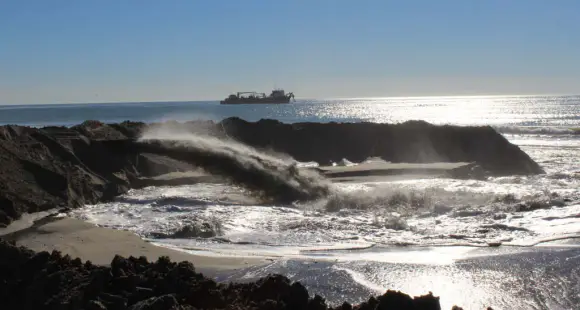Over the past two months, a 315-foot boat named Liberty Island has been stalking close to our coastline. This vessel is the dredge doing much of the work to complete the 2012 Regional Beach Sand Project. This $28 million undertaking is a joint venture of the San Diego Association of Governments, the State Department of Boating and Waterways, and the coastal cities involved.According to SANDAG signs posted at pumping sites, “The San Diego Regional Beach Sand Project is widening beaches from Imperial Beach to Oceanside by adding approximately 1.5 million cubic yards of clean, high quality sand to our eroded shoreline.”
Our beaches are in a constant state of natural change. Tides ebb, bluffs erode, kelp decomposes, large winter storms take sand off the beach and calmer summer conditions bring the sand back. These cycles are eternal. However, human development in the coastal region has an impact on the natural state of our coastlines.
Seawalls prevent the natural erosion of seaside bluffs that break down to replenish sand. Jetties and harbors prevent the natural flow of sand up and down the coast. Development in and around lagoons impacts the flow of sediments from the watershed to the beach. Because of these endeavors, our beaches shrink as natural sand replenishment is obstructed.
The 2012 Regional Beach Sand Project hopes to alleviate these threats to our beaches. The project FAQ, available at sandag.org, states, “The goals associated with sand placement are to restore and maintain coastal beaches, sustain recreation and tourism, enhance public safety, restore coastal sandy habitats, and reduce the proliferation of protective shoreline structures (e.g., harbors and jetties).”
Locations receiving sand include: Imperial Beach, Fletcher Cove in Solana Beach, Cardiff Beach, Moonlight Beach, North and South Carlsbad Beach and Oceanside. The work began in September as bid winner Great Lakes Dredge and Dock Company sent the Liberty Island from the East Coast, through the Panama Canal to Imperial Beach. IB’s sand replenishment finished up in early October. The project will continue through December for the North County.
The Liberty Island dredge vacuums sand out of deposits within two miles of the shoreline. The sand is held in the vessel’s gigantic hold as it then positions itself next to a floating pump connected to pipes that run onto the beach. The nourishment is done in 500-foot sections and then the pipes are moved until the fill is finished at each beach. Heavy equipment then moves the sand into optimal positions.
In 2001, 2 million cubic yards of sand were dredged and pumped onto county beaches. The results of that project were closely monitored. According to SANDAG, the sand from the 2001 replenishment stayed in the system for an average of five years and some of that sand is still here today. The main difference between 2001 and 2012 is that sand with larger grains are now being collected because they stay on the beach longer.
The Surfrider Foundation is using a video monitoring system to evaluate the project’s impact on surf quality. Will the new sand build excellent sandbars and create better waves at local beachbreaks? Will the new sand smooth-over dynamic reef systems and ruin some of our best reef breas? Surfrider is recording 10 minutes of video every morning at six surf spots throughout the county. The videos will be analyzed to better understand the impacts that the 2012 Regional Beach Sand Project has on our beloved waves.

